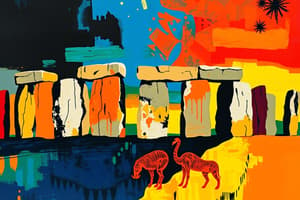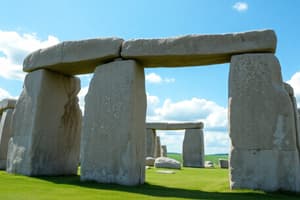Podcast
Questions and Answers
In which city did Archbishop Reynald von Dassel bring home the bones of the three wise men in the 12th century?
In which city did Archbishop Reynald von Dassel bring home the bones of the three wise men in the 12th century?
- Cologne (correct)
- Paris
- Venice
- Florence
What material was used for the construction of the Cologne Cathedral from 1855 to 1860?
What material was used for the construction of the Cologne Cathedral from 1855 to 1860?
- Metal (correct)
- Wood
- Stone
- Brick
Where does the eerie pathway inside the Cologne Cathedral lead to?
Where does the eerie pathway inside the Cologne Cathedral lead to?
- The entrance
- A hidden chamber
- The crypt
- A vantage point (correct)
How many craftsmen work every day on constructing and restoring the Cologne Cathedral?
How many craftsmen work every day on constructing and restoring the Cologne Cathedral?
What century saw the construction of one of the biggest metal structures in Europe at the Cologne Cathedral?
What century saw the construction of one of the biggest metal structures in Europe at the Cologne Cathedral?
Which city is mentioned as a great side trip from Paris in VID 2?
Which city is mentioned as a great side trip from Paris in VID 2?
What does cave art provide evidence of?
What does cave art provide evidence of?
What is one of the purposes ascribed to Stonehenge in the text?
What is one of the purposes ascribed to Stonehenge in the text?
Why is Stonehenge associated with Merlin the Magician from King Arthur’s story?
Why is Stonehenge associated with Merlin the Magician from King Arthur’s story?
How did Neolithic art differ from Paleolithic art, according to the text?
How did Neolithic art differ from Paleolithic art, according to the text?
What led to the shift from naturalistic art to geometrically abstract art according to the text?
What led to the shift from naturalistic art to geometrically abstract art according to the text?
What were the designs on Neolithic clay pots commonly derived from?
What were the designs on Neolithic clay pots commonly derived from?
What was a key factor that led early humans to transition from a nomadic lifestyle to a permanent one?
What was a key factor that led early humans to transition from a nomadic lifestyle to a permanent one?
Which civilization was known for being divided into Old, Middle, and New Kingdoms?
Which civilization was known for being divided into Old, Middle, and New Kingdoms?
During which period did Egyptian art flourish?
During which period did Egyptian art flourish?
What types of structures were famous in Egyptian Art?
What types of structures were famous in Egyptian Art?
What was a common feature of artwork produced by cultures once basic human needs are met?
What was a common feature of artwork produced by cultures once basic human needs are met?
Which period in Egypt marked the beginning of the process of producing art?
Which period in Egypt marked the beginning of the process of producing art?
What is the main architectural style of the Chartres cathedral?
What is the main architectural style of the Chartres cathedral?
What event led to the rebuilding of the earlier church at Chartres?
What event led to the rebuilding of the earlier church at Chartres?
What is Chartres most famous for in terms of its art?
What is Chartres most famous for in terms of its art?
What architectural feature allowed Gothic churches to have more windows?
What architectural feature allowed Gothic churches to have more windows?
What does the text refer to as 'The Book of Chartres'?
What does the text refer to as 'The Book of Chartres'?
Who is the Chartres cathedral dedicated to?
Who is the Chartres cathedral dedicated to?
What is Leonardo da Vinci's famous painting that features a new renaissance technique called perspective?
What is Leonardo da Vinci's famous painting that features a new renaissance technique called perspective?
Where was Michelangelo's statue of David originally placed before it was moved inside to protect it?
Where was Michelangelo's statue of David originally placed before it was moved inside to protect it?
What was special about the structure of Filippo Brunelleschi's dome for Santa Maria del Fiore in Florence?
What was special about the structure of Filippo Brunelleschi's dome for Santa Maria del Fiore in Florence?
What was Leonardo da Vinci's famous technique that he incorporated into his paintings to avoid harsh outlines?
What was Leonardo da Vinci's famous technique that he incorporated into his paintings to avoid harsh outlines?
Which of the following activities was NOT among Leonardo da Vinci's areas of expertise?
Which of the following activities was NOT among Leonardo da Vinci's areas of expertise?
'Friends of Florence' and 'Friends of David' are organizations dedicated to what purpose?
'Friends of Florence' and 'Friends of David' are organizations dedicated to what purpose?
'La Gioconda' is an alternative name for which famous Leonardo da Vinci painting?
'La Gioconda' is an alternative name for which famous Leonardo da Vinci painting?
'Sfumato' is a technique used by Leonardo da Vinci that specifically aims to avoid what in paintings?
'Sfumato' is a technique used by Leonardo da Vinci that specifically aims to avoid what in paintings?
'The Vitruvian Man' by Leonardo da Vinci explains the proportions of what?
'The Vitruvian Man' by Leonardo da Vinci explains the proportions of what?
'Baroque' is a term derived from which languages according to Merriam-Websters dictionary?
'Baroque' is a term derived from which languages according to Merriam-Websters dictionary?
Flashcards are hidden until you start studying
Study Notes
Leonardo da Vinci
- Born in 1452 in Vinci, Italy, as an illegitimate child
- Apprenticed under Verrocchio in Florence at 15 and refined his skills
- Developed his unique technique called sfumato, which avoids harsh outlines and gives paintings a sense of depth
- Surpassed his teacher Verrocchio and became a professional painter in Milan
- Completed the Virgin of the Rocks and the Last Supper in Milan, using a new Renaissance technique called perspective
- Focused on scientific studies and drew plans for various inventions, including flying machines, water systems, and bridges
- Made meticulous illustrations and entries in his notebooks, revealing his true genius
- Drew the Vitruvian Man, a drawing that explains the proportions of the human body
- Painted the Mona Lisa, which is still widely admired today
Michelangelo
- Created the statue of David in 1501, a masterpiece of Renaissance art
- Worked in secrecy on the statue, which was finally unveiled to a gasp of wonder
- The statue depicts David, rock in hand, preparing to defeat Goliath
- The statue is considered a masterpiece and has been admired for nearly 400 years
Filippo Brunelleschi
- Built the dome of Santa Maria del Fiore in Florence, Italy, in 1418
- Proposed a daring plan using innovative methods to build the dome
- Designed an inner and outer shell held together by giant brick arches and interlocking rings of stone and wood
- Built machines to move heavy loads and lay bricks in a herringbone pattern
- Completed the dome in 16 years, leaving behind no sketches or details of how he achieved it
Baroque
- The term "Baroque" comes from Middle French or Portuguese
- No further information provided about the Baroque period or style
Cologne Cathedral
- Built in Cologne, Germany, in the 12th century to house the relics of the three wise men
- Constructed on a spiritual site with a wooden construction and metal framework
- Features an eerie pathway and beautiful stained glass
- Has undergone restoration and construction work, with 100 craftsmen working on it daily
- Remains an architectural masterpiece and a testament to the city's history
Chartres Cathedral
- Built in Chartres, France, in the 13th century
- Rebuilt after a fire in 1194, with a unified architecture, statuary, and stained glass
- Captures the spirit of the 13th century, the "Age of Faith"
- Features Gothic architecture, with columns, pointed arches, and buttresses
- Famous for its stained glass and statues, which tell the story of the Christian faith
Early Civilizations
- Early humans transitioned from a nomadic lifestyle to a permanent one, leading to the development of early civilizations
- Paleolithic art focused on cave paintings and was a product of climate change
- Neolithic art developed when life became more stable, featuring geometrically abstract designs and monumental structures
- Egyptian art flourished during the Old, Middle, and New Kingdoms, with famous structures like pyramids and mortuary temples
- Art is an essential aspect of any civilization, often emerging simultaneously with basic human needs like food, shelter, and community law
Studying That Suits You
Use AI to generate personalized quizzes and flashcards to suit your learning preferences.



